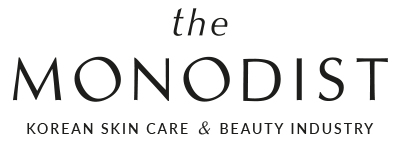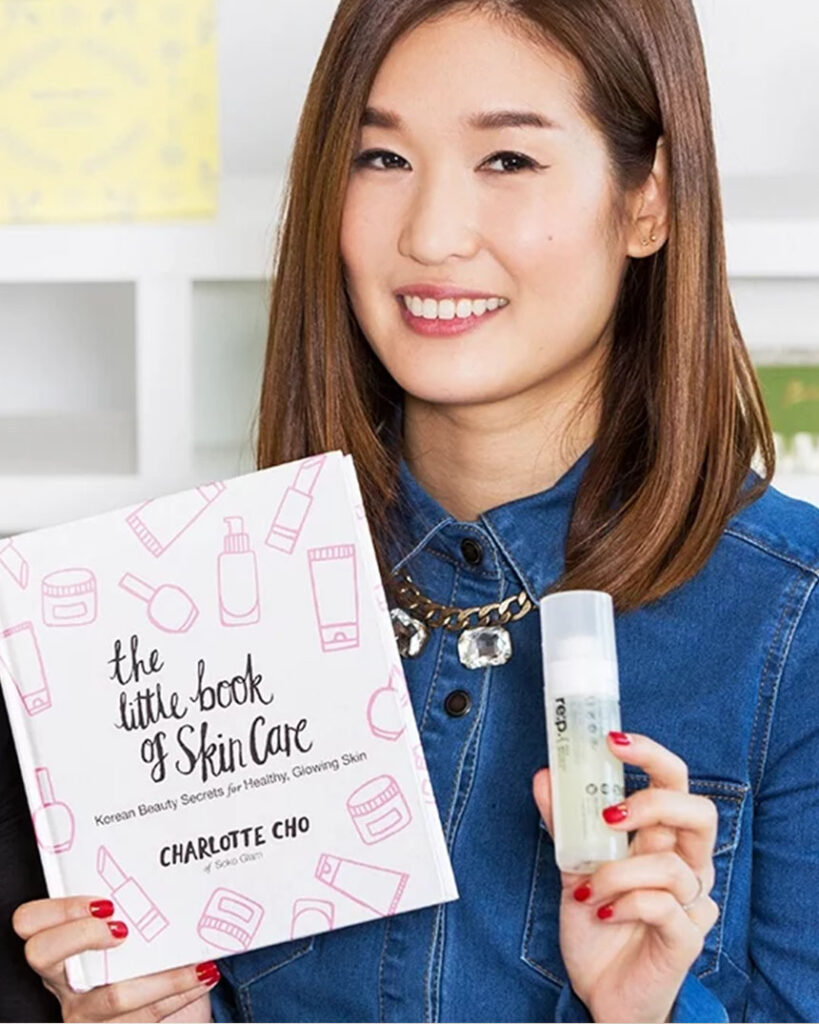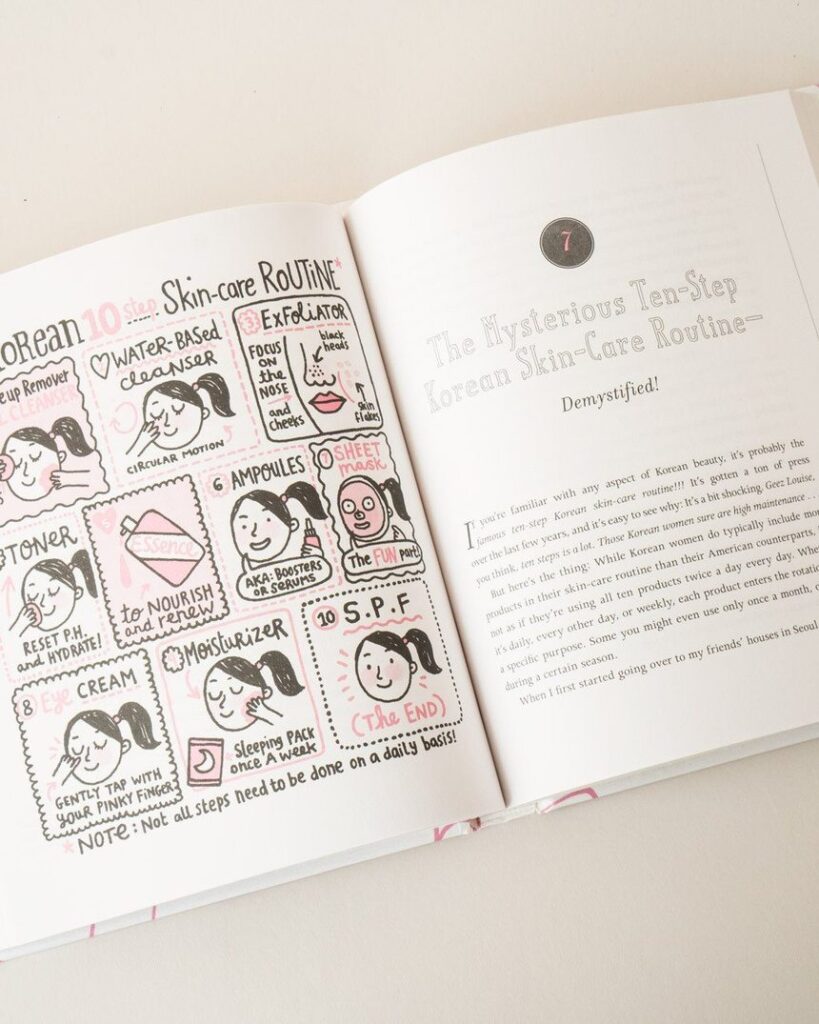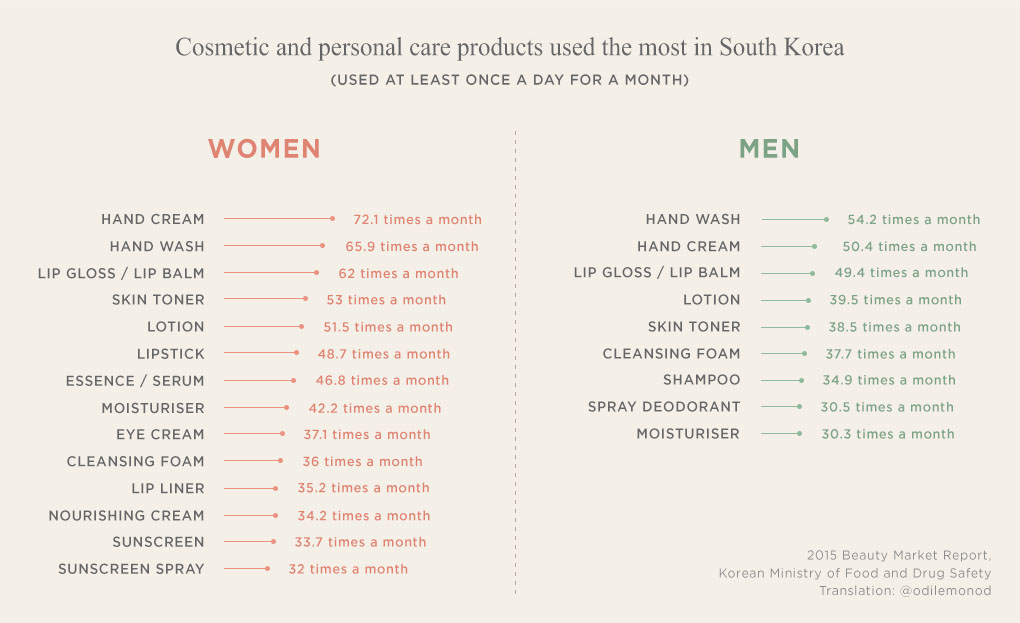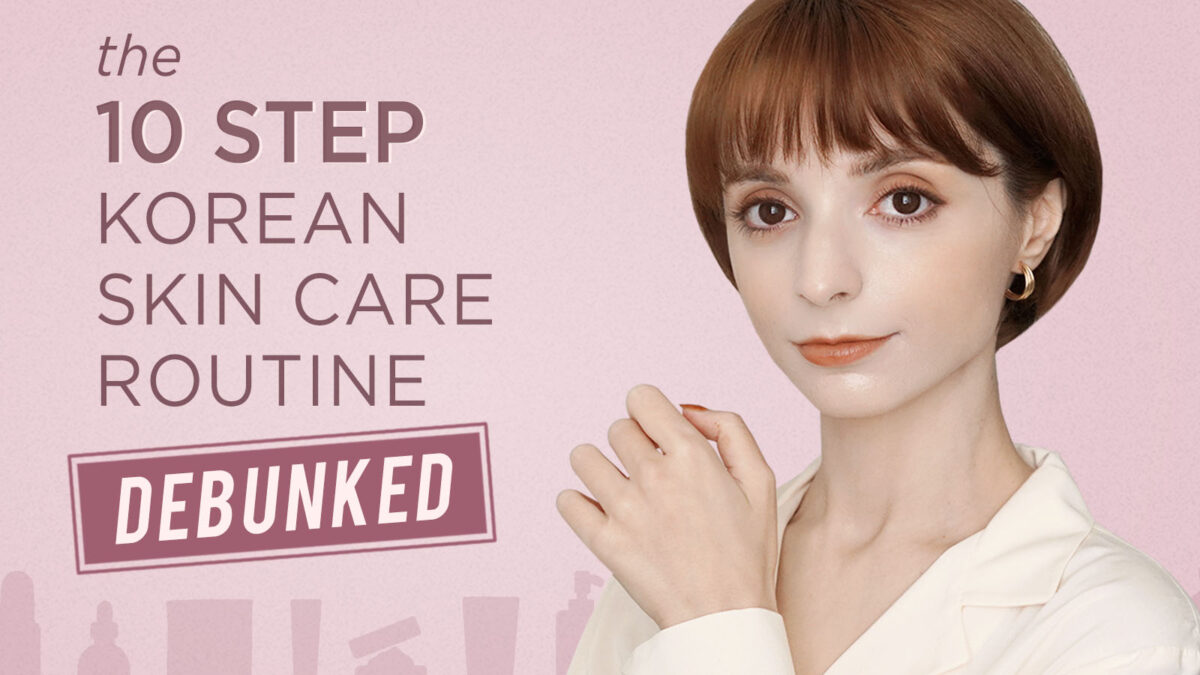
The 10 Step Korean Skin Care Routine Is Not Real (And Never Was)
Even if you’re new to Korean Beauty, chances are you probably heard of the “10 Step Korean Skin Care Routine” – an elaborate multi-step skin care routine that allegedly originated in South Korea.
In its original form, the routine consisted of: an oil-based cleanser, a water-based cleanser, an exfoliator, a toner, an essence, a face treatment, a sheet mask, an eye cream, a moisturiser and a sunscreen.
For many years, Western beauty retailers and magazines presented the 10 Step Korean Skin Care Routine as the secret behind the perfect skin of Korean celebrities, a mystic ritual that all Korean women, or at least most Korean women, followed twice a day every single day to get the perfect glass skin.
However, this couldn’t be further from the truth, as I’m going to break down in this article.
Contents:
The 10 Step Korean Skincare Routine in Korean media
There’s a stark contrast between the way the “10 Step Korean Skincare Routine” is presented in Western media outlets and the opinions of the Korean beauty press.
While foreign media describes the lengthy routines as a daily practice all Korean women, or at least most of them, engage in, Korean beauty journalists share a different opinion.
Below is a telling excerpt from an article published by the professional beauty magazine Daily Cosmetic (뷰티경제) in 2014.
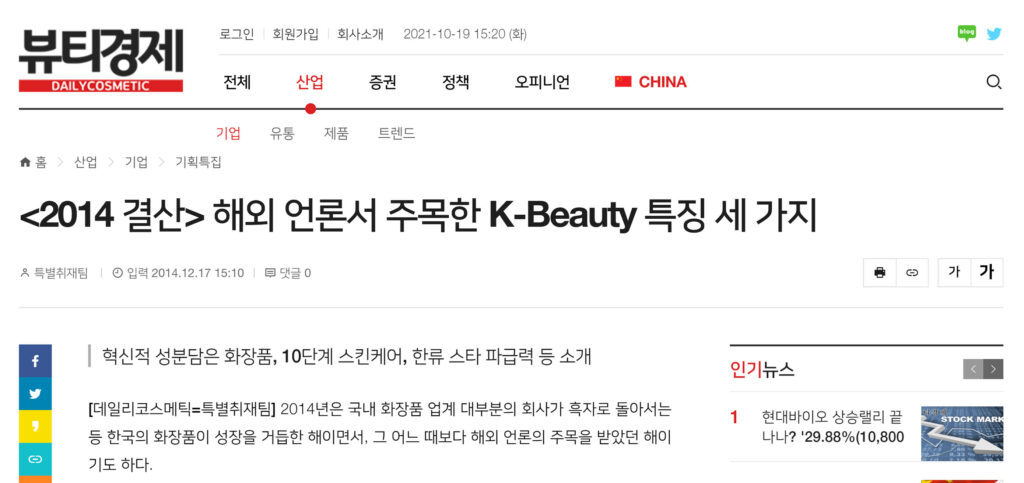
(source: Daily Cosmetic)
Beauty news websites like Byrdie, Fashionista and Into The Gloss, reported: “Koreans follow a 10 step skin care routine. Some of these products do not exist in the US, and they should be applied following a specific order and in a specific way”.
The “10 Steps” seems to derive from the fact the lines launched by Korean beauty brands usually consist of 6-10 consecutive products like skin, toner, ampoule, emulsion, essence, serum, lotion, cream, sleeping pack, and oil.
Very few Koreans use all these products when they do their skincare routine, but it’s true that Koreans use many products compared to Westerners, many of whom have a skincare routine that consists of only one cream. Therefore, it seems American beauty media is taking the initiative to come up with new trends for the foreign market, like the “10 Step Skin Care Routine”, as a way to introduce Korean trends.
Daily Cosmetic (뷰티경제), 2014
In 2018, the Korean beauty magazine Beauty+ wrote a long article investigating the cultural impact of the “10 Step Korean Skincare Routine” abroad and also raised some important questions on its legacy.
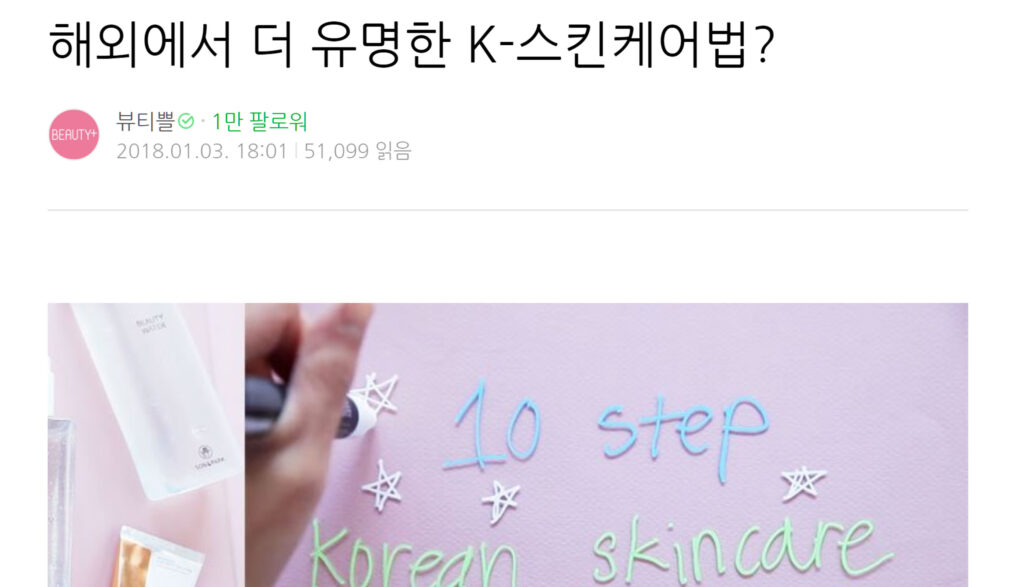
(source: Beauty+)
[the problem with the 10 step skincare routine] is that it’s focused on recommending “Korean products” rather than picking products based on your personal skin condition. i.e. Step 1 is always a cleansing balm (why?). It’s a product with excellent cleansing power but it can cause more blemishes for oily skin types. There should be a proper guide on the real Korean skincare routine.
Beauty+ Magazine, 2018
Another poignant example is a 2019 video from a Canada-based Korean youtuber named DAS 다스 .
In the words of the youtuber:
Online retailers and brands are really pushing this idea of “10 Steps of Korean Skincare” so that when you hear of “Korean Skincare” you immediately think about “10 Steps” and they’re selling it as a starter kit with 10 different products. (…) What I’m worried about is that this “10 Step Routine” thing is actually holding you back from exploring this beautiful world of Korean skincare and controlling you to buy what they want to sell.
DAS 다스
Origins of The 10 Step Korean Skin Care Routine
The keyword “10 Step Korean Skin Care Routine” started to appear around 2014, as shown by Google Trends data.
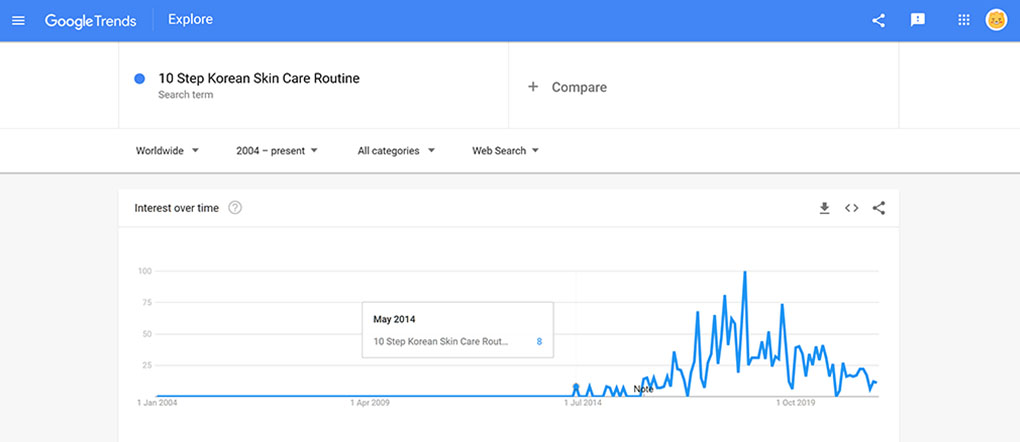
(source: Google Trends)
Although there are a few articles published before this date that mention the general concept of multi-step Korean skincare routines, the first appearance of the term “10 Step Korean Skincare” can be traced back to an article published on American beauty magazine Into The Gloss in April 2014. In the article K-Beauty expert Charlotte Cho introduces readers to some popular Korean skincare product categories that are not available in the US, while explaining how to layer these formulas and build a skincare routine.
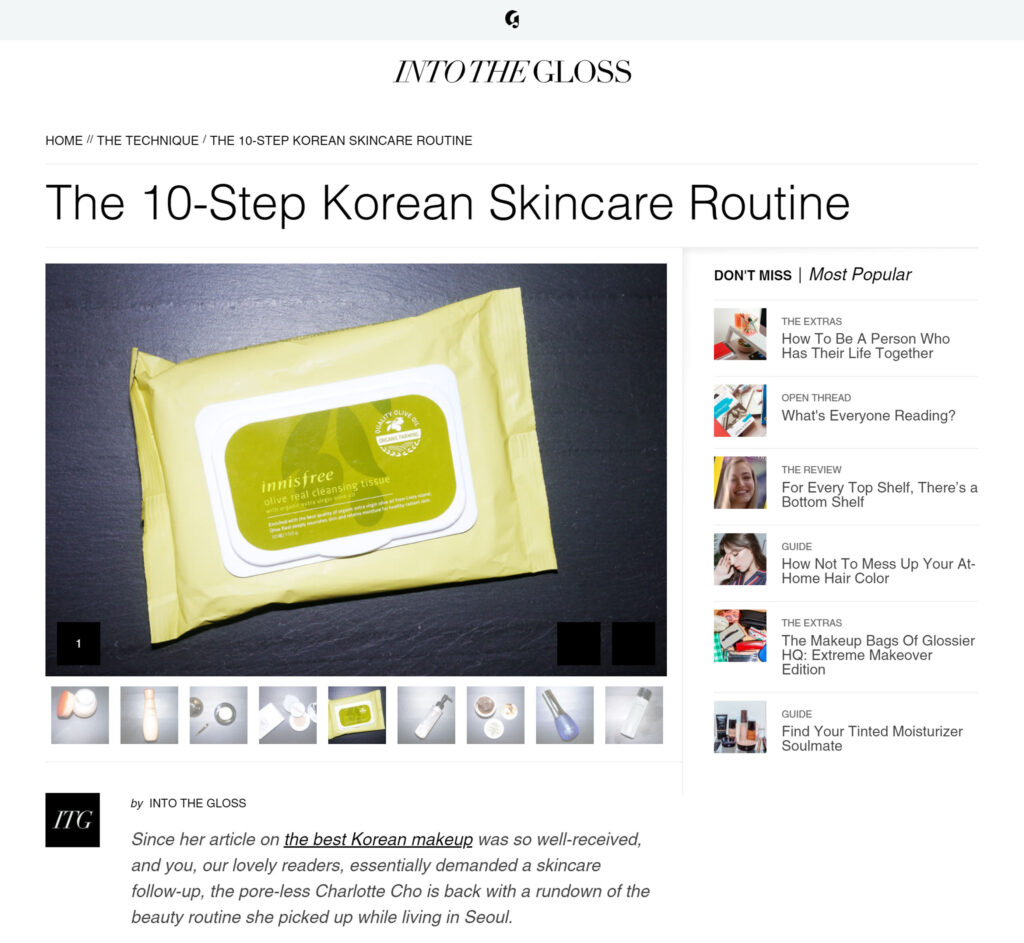
(source: Into The Gloss)
Charlotte Cho is a Korean-American entrepreneur and co-founder of Soko Glam, an American website founded in 2012 with the mission of bringing Korean beauty products to a Western audience. Cho rose to international fame in 2015, when she published “The Little Book of Skin Care”, the first English-language book dedicated to Korean beauty.
In the book she explains once again how to create a skincare using 10 popular Korean products and dubs this practice as the “10 Step Korean Skincare Routine”. Although the author never openly states that Koreans actually follow this elaborate routine, the book implicitly suggests that was how Korean skincare was designed to work. Shortly after the publication of “The Little Book of Skin Care”, Western media outlets picked up the story and created a mythology around the “10 Step Skincare Ritual that Koreans are obsessed with” and that’s why, in the mind of many foreigners, the “10 Step Korean Skincare Routine” is still considered synonymous with Korean beauty to this day.
To be fair, Cho has always been very open about the fact that the “10 Step Korean Skin Care Routine” was something she came up with and in many interviews she candidly admits the “10 Step Skin Care Routine” was never an actual thing in Korea.
However, it’s important to keep in mind that she’s still a business owner who sells 10 Step Korean skincare starter kits on her website, so even though she’s always been very transparent about the nature of this routine, it’s hard to imagine she was too pressed about dispelling the myth.

(source: VOX Magazine)
An Overview of Cosmetics Consumer Behavior in South Korea
Korean beauty is notoriously a fast-paced and ever-changing industry, which makes it hard to make generalisations about its dynamics.
To dissect the myth of the “10 Step Korean Skincare Routine”, it’s important to look back at how the Korean Beauty industry looked like in 2015, when Charlotte Cho published the book that popularised the myth.
According to a study conducted by the Korean Ministry of Food and Drug Safety, this was the average number of cosmetic and personal care products used monthly by Koreans in 2015.
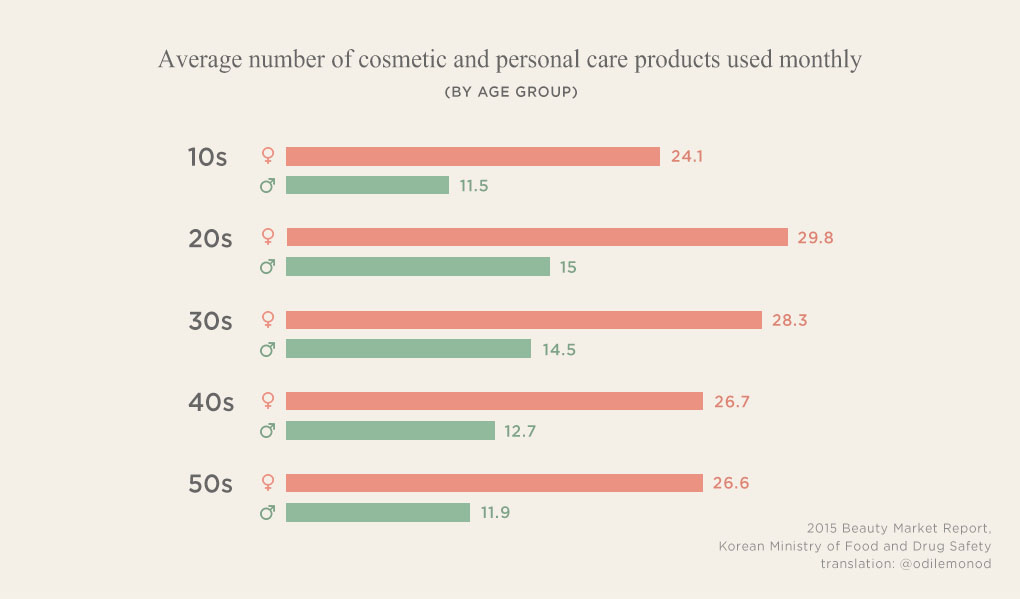
These numbers might seem really high at first glance, but one should keep in mind that the study takes into consideration both cosmetics (i.e. skincare, colour makeup etc.) and personal care products (i.e. shampoo, body wash etc).
Looking just at skin products, the average number of products used monthly by Koreans in 2015 was found to be 9.9 for women (7.1 skincare products + 2.8 cleansing products), and 4.8 for men (3.6 skincare products + 1.2 cleansing products).
In addition, the Korean MFDS was also able to identify the most popular product categories used at least once a month by the majority of partecipants in the study.
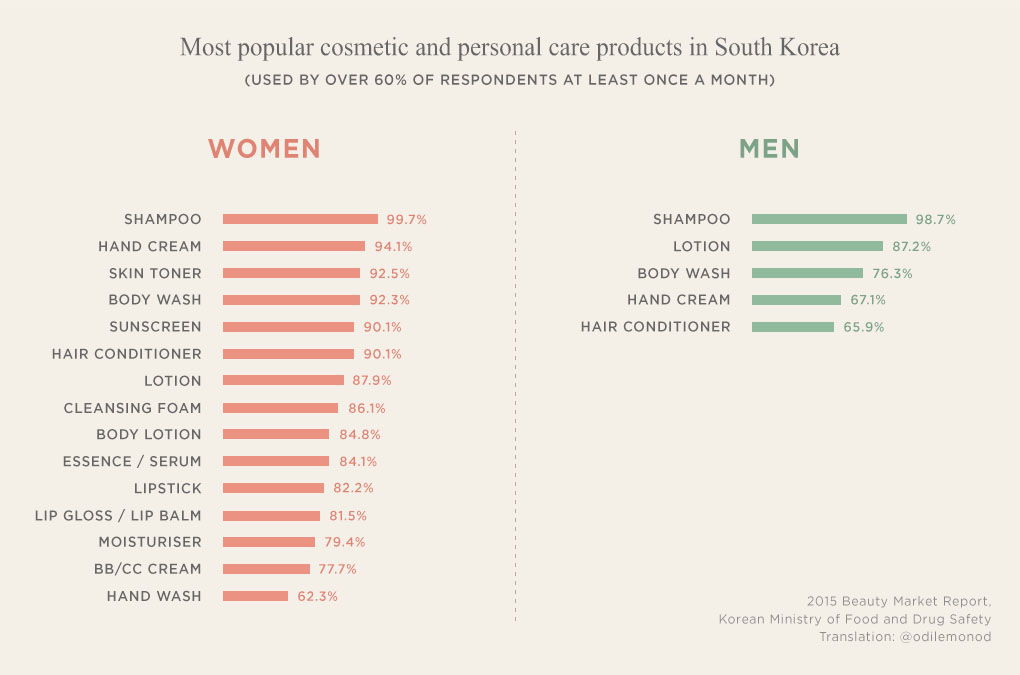
[note: the study groups “Essence” and “Serum” together because they’re widely considered equivalent products in South Korea. Please refer to this post I wrote on the topic].
Furthermore, the Korean MFDS analysed usage patterns of 72 types of cosmetics and personal care products and determined which ones were used most frequently by Koreans. The resulting data gives us a glimpse of how the average daily skincare routine of a Korean woman in 2015 might have looked like.
Morning:
Skin Toner (+ Essence/Serum every other day) + Lotion + Moisturiser + Sunscreen + Sunscreen Spray (for reapplication during the day) (= total 5/6 skincare products).
Evening:
Cleansing Foam + Skin Toner + Essence/Serum + Lotion + Eye Cream + Nourishing Cream (= total 5 skincare products + 1 cleansing product).
Average number of different types of skin products used in a day (morning + evening):
8 skincare products + 1 cleansing product.
A reflection of these statistics can be seen in the composition of the skincare gift sets that used to be popular at the time.
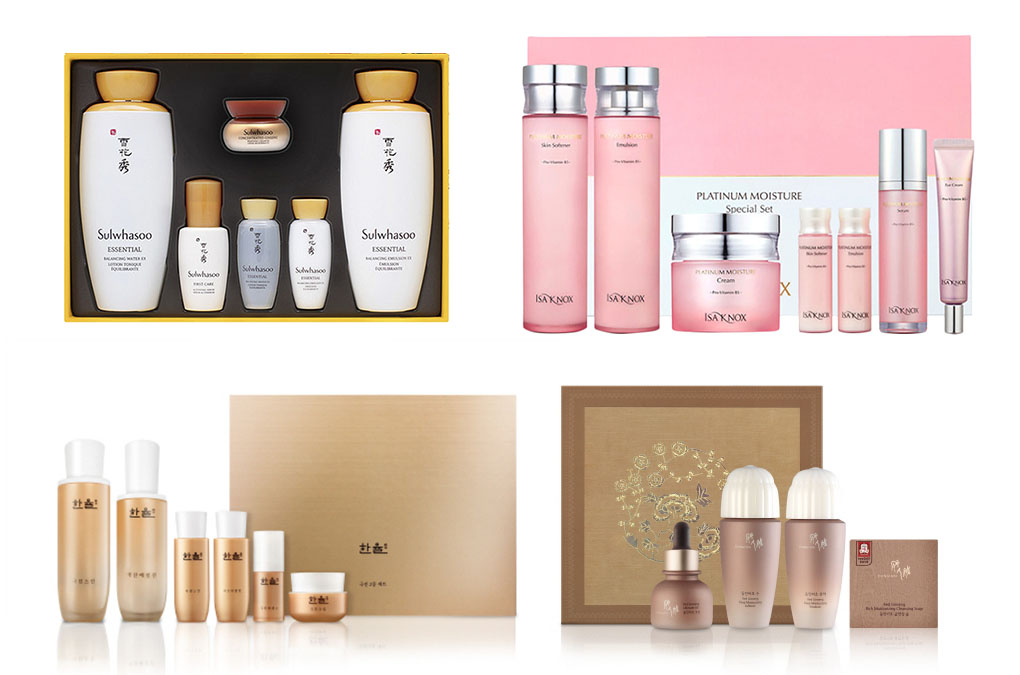
(L-R Sulwhasoo, Isa Knox, Hanyul, Donginbi)
This reveals that most Korean women do not have lengthy 10 step skincare routines like the myth of the “10 Step Korean Skincare Routine” seems to suggest. Plus, it also sheds an interesting light on the cleansing habits of Korean women in 2015. Despite the mythology surrounding “double cleansing” in the West, the majority of participants in the study stated they only used one type of cleanser (cleansing foam) every single day, while other types of cleansers (cleansing oil, cleansing balm, micellar water) were used less frequently and this tells us that many Korean women do not in fact double cleanse every single day.
To paint a more accurate picture, below is the average daily number of skincare and cleansing products used by Koreans in the following years.
2016
Women: 5 skincare products + 1 cleansing product (survey of 892 Korean women aged 15-59 – Korean Ministry of Food and Drug Safety, 2016)
Men: 3 skincare products + 1 cleansing product (survey of 908 Korean men aged 15-59 – Korean Ministry of Food and Drug Safety, 2016)
2017
Women: 8 skincare products + 1 cleansing product (survey of 955 Korean women aged 15-59 – Korean Ministry of Food and Drug Safety, 2017)
Men: 4 skincare products + 1 cleansing product (survey of 583 Korean men aged 15-59 – Korean Ministry of Food and Drug Safety, 2017)
Studies for the following years were conducted by a private market research company and are based on the average weekly number of products (as opposed to daily).
2018
Women: 5 skincare products + 1.8 cleansing products (survey of 1500 Korean women aged 20-49, Opensurvey 2018
Men 3.4 skincare products + 1 cleanser (survey of 500 Korean men aged 20-39, Opensurvey 2018)
2019
Women: 5 skincare products + 1.85 cleansing products (survey of 1500 Korean women aged 20-49, Opensurvey, 2019)
Men: 3.6 skincare products +1 cleansing product (survey of 500 Korean men aged 20-39, Opensurvey 2019)
2020
Women: 5.1 skincare products + 1.85 cleansing products (survey of 1500 Korean women aged 20-49 – Opensurvey 2020)
Men: 3.5 skincare products + 1 cleansing product (survey of 750 Korean men aged 20-39 – Opensurvey 2020).
2021
Women: 3 skincare products (survey of 1500 Korean women – Kantar Korea 2021)
2022
Women: 5 skincare products per day + 1 cleansing product (survey of 1500 Korean women aged 20-49, Open Survey 2022)
As shown by these numbers, in recent years the tendency in South Korea has been to minimize skincare steps to avoid potential irritation. The phenomenon is often referred to as “Skip-Care” of “Skincare Diet“.
According to a study of 1500 Korean women conducted by market research company Kantar, the majority of Korean women (28%) use an average of 3 products in the morning, while 23% only use 2 products (cleansers were not included in the study).
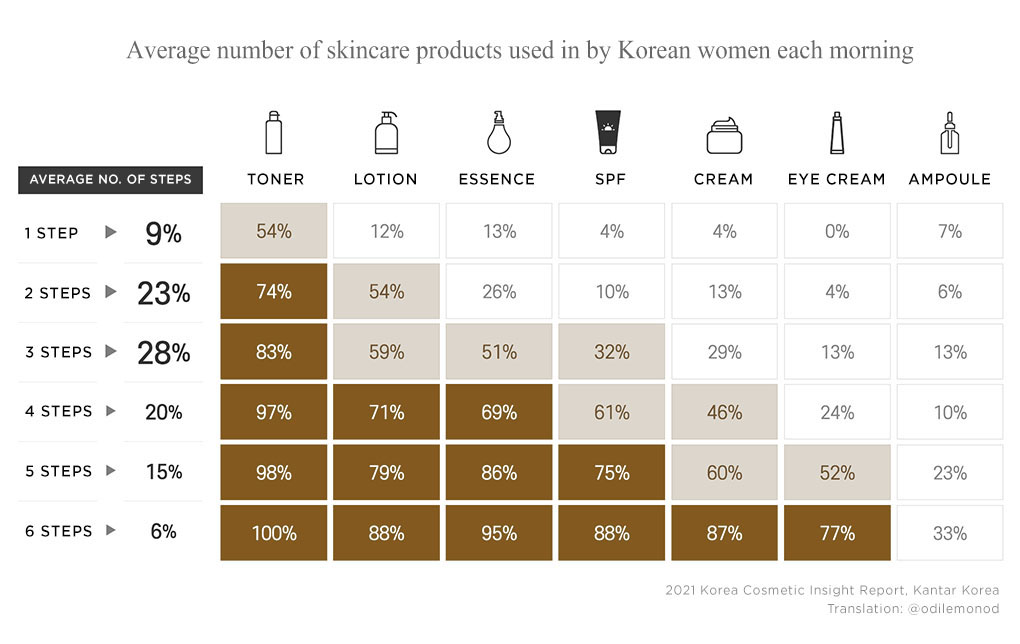
(source: Kantar Korea)
We can conclude that, not only the “10 Step Korean Skincare Routine” was not real in 2015 when the myth started to gain momentum in the US, but it’s even less real now. Overall, in the past Korean women used to have relatively elaborate skincare routines of around 6-7 steps, but in the latest years they streamlined their routine to 2-3 daily steps.
Personal Considerations
Shortly after the first articles on the “10 Step Korean Skincare Routine” appeared in the US, some beauty editors saw the idea of this elaborate routine as an opportunity to create a story around the extravagant beauty rituals coming from Asia.
Words like “unusual”, “eccentric” or “weird” immediately started to be associated with Korean Beauty practices. This othering attitude can be attributed to what Edward Said described as “Orientalism“.
Orientalism can be discussed and analysed as the corporate institution of dealing with the Orient – dealing with it by making statements about it, authorising views of it, describing it, by teaching it, settling it, ruling over it; in short, Orientalism as a Western style of dominating restructuring and having the authority over the Orient.
Edward W. Said
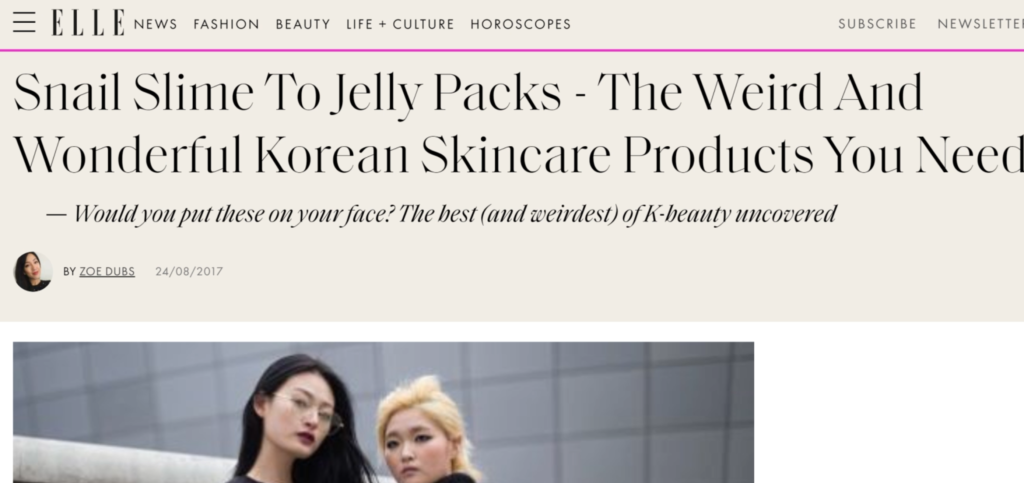
(Elle Magazine, 2017)
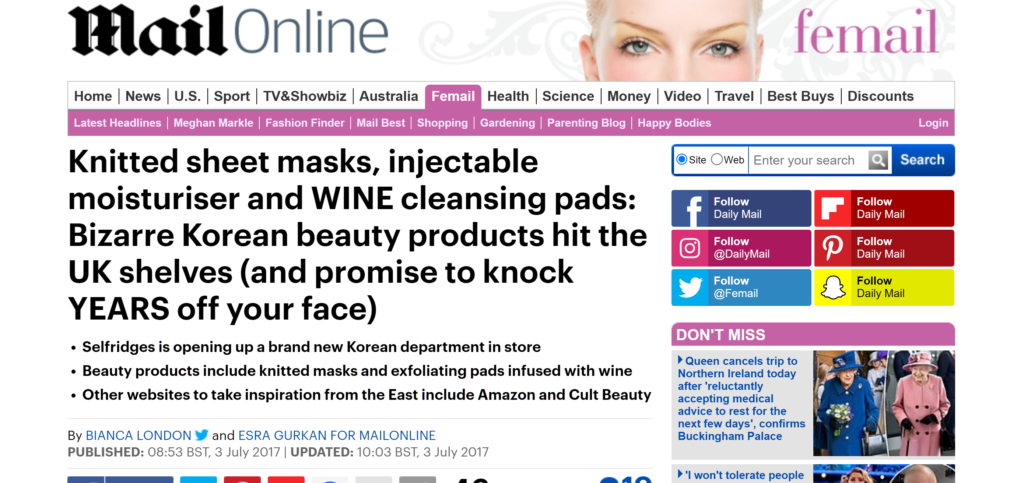
(Daily Mail, 2017)
While these articles might seem positive on the surface, the underlying message they send is that Asians like to engage in eccentric activities because they’re not as civilised as Westerners.
That’s the biggest problem I have with the popularisation of the “10 Step Korean Skin Care Routine” myth: it’s deeply dehumanising. It makes Koreans appear like crazy people with no priorities in life who are more than happy to spend several hours a day taking care of their skin, when actually they’re people just like you and me. Many of them are overworked or out of employment and they don’t have the time, the energy or the financial means to support this kind of extravagant lifestyle.
The second problem I have with the “10 Step Korean Skin Care Routine” is that it sends the wrong message to people that are just starting out with skincare. It tells them that there’s a standard skincare routine that fits everyone and it doesn’t encourage people to learn to understand their real skin needs.
Plus, as someone who works in beauty marketing in South Korea, and who gets to see every day the real potential of Korean beauty, the innovation, and the excellence this industry is capable of, I find it frankly disheartening that this marketing stunt is internationally considered to be the most representative part of the Korean beauty industry.
Conclusion
In conclusion, the 10 Step Korean skincare routine is simply a marketing gimmick originated in the United States around 2014. Foreign K-Beauty retailers and beauty magazines were the main driving forces behind this myth, as they saw it as an opportunity to easily sell 10 different products to casual customers fascinated by the idea of Korean skincare. The phenomenon had no basis in reality and does not reflect the habits of Korean consumers, nor the dynamics of the Korean beauty industry.
Resources
- <2014 결산> 해외 언론서 주목한 K-Beauty 특징 세 가지, 뷰티경제, 2014.12.17
해외에서 더 유명한 K-스킨케어법?, Beauty+, 2018.01.03 - Rituals and Myths of Korean Skin Care Practices: The Emergence of K-beauty inthe Global Marketplace, Yoo Jin Kwon, 2020.10
- “10 Step Korean Skin Care routine” search volume analysis (2004-), Google Trends
- 뷰티 트렌드 리포트 2015, Opensurvey 2015.04.03
- “The 10-Step Korean Skincare Routine”, Into The Gloss, 2014.04
- How the 10-step Korean skin care routine changed American skin care, Vox, 2019.01.17
- The Creator of the 10-Step K-Beauty Skin-Care Routine Says We’ve All Been Doing It Wrong, Well+Good 2019.03.27
- Charlotte Cho Teaches Us About The K-beauty Glow, The Wellnest, 2020.06.26
- Korea Unemployment at 21-Year High as a Million Jobs Lost, Bloomberg, 2021.02.10
- South Koreans are working themselves to death. Can they get their lives back?, CNN, 2018.11.05
